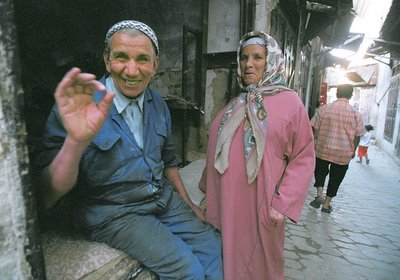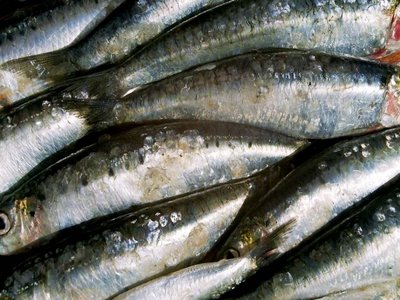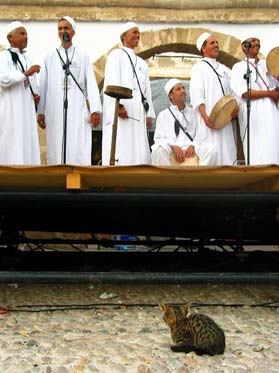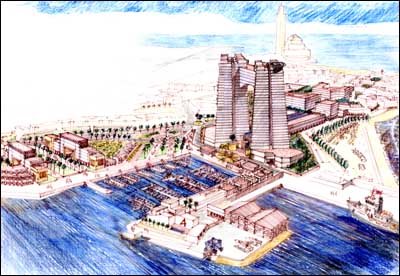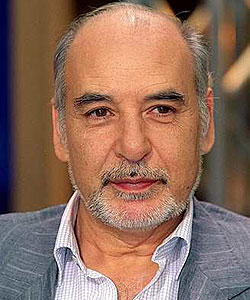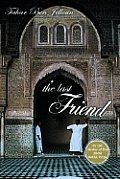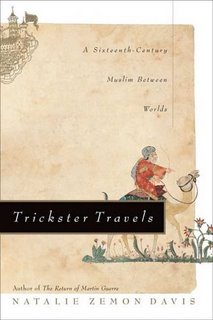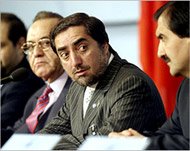If you are contemplating a trip to Morocco, your biggest problem will be deciding what to see and what to miss. The kingdom is as culturally rich as it is geographically diverse and cannot fail to impress. Here is a quick guide to the "must see" attractions on the coastal side of the Atlas mountains. We will visit the Sahara and kasbah country in a later post.
Fez is the bustling cultural and spiritual centre of Morocco.
The main attraction in Morocco is Fez and central to that attraction is the
medieval medina in the colourful old city, which has been continuously inhabited since the 10th century. It is busy with traditionally dressed Moroccans, and rich with the noise of buying and selling, veiled women going about their work and bell-ringing water sellers. It is the last living medina on the planet and to enter it is to enter a time warp that takes you back hundreds of years. There are other medinas, but none approach the extraordinary experience that is Fez.
This is not a place for a single day, so, if possible, give yourself at least a week. At first glance a guided tour is the easiest way to tackle the buzzing hive that is traditional Fez, but if you are brave, you can negotiate the tiny alleyways, too narrow for cars whilst risking getting lost and then haggling with a local to be guided back out! After the first day or two you will be ready to explore on your own and for further information on how to do that, check out our post:
Walking the Fez Medina.
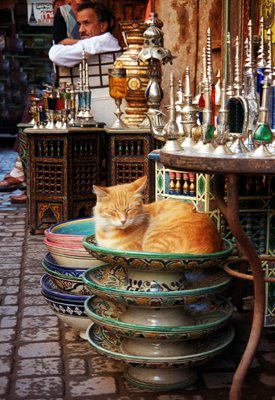
See also our post of pictures from around the souks of Fez:
Around the souqs and
Faces in the Medina Also, if you want a unique experience:
A visit to the hammam
The Tanneries: A visit to the souks will lead to a visit to Fez's famous tanneries, where one of the oldest arts in the world is practiced to produce the soft leather do characteristic of Morocco. Many people warn you that you’ll need a strong stomach for the smells given off during curing, while you look down on the fascinating tanners’ yard and its impressive 1000 year old vats of different coloured dyes and piles of skins. However it is not as bad as some sensetive souls insist! Open 9-6, admission free.
View Point: The best vantage point over the ancient walled city is from the ruined Merenid Tombs on a hilltop to the east of the city. From here you can see the skyline with its profusion of satellite dishes, and a general mass of palaces, green-roofed holy places, the tanneries, as well as the adjacent Karaouine Mosque. Sunrise and sunset can be wonderful times to get the best photographs.
Moulay Idriss ll: In the depths of the old city sits the shrine that houses the remains of the founder of the city of Fez, Moulay Idriss II. It is one of the holiest buildings in the city. Non-Muslims may not enter, but you can glimpse inside to see the saint’s tomb, which is receives constant devotional visits from groups of women who burn candles and incense.
A couple of hours from Fez you will find
Volubilis: it was built on top of a previous Carthaginian city and dates back to around the 3rd century BC, being a centre of Roman administration in Africa. Volubilis was inhabited until the 18th century, when it was carelessly demolished to provide building materials for the palaces of Moulay Ismail in Meknes. This meant a great deal of Morocco’s Roman architectural heritage was lost. However, today the ruins include some well-preserved columns, a basilica, a triumphal arch and about 30 beautiful mosaics.
Marrakech

Walking through the alleyways and souks of Marrakech, particularly in the Medina of the old city, it is easy to believe you have been transported back in time to the “Arabian Nights”. It is this enchanting mood that brings thousands of sightseers to the most visited of Moroccan cities.
The Medina while not as interesting as that in Fez, is characterized by much noise, hustle and bustle with tradesmen and craftsmen going about their daily tasks of cloth dying, copper beating or leather working, as well as herbalists, perfumers and slipper makers. Snow-covered peaks of the High Atlas Mountains form a beautiful backdrop for the city, although they are often hidden by the heat haze.
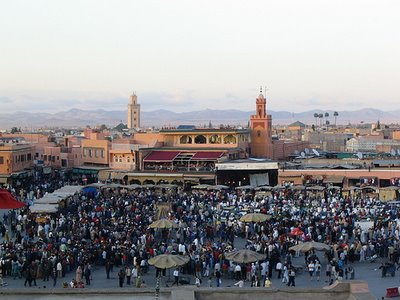
Djemaa el-Fna: On the edge of the Medina. It is an irregular 'square' and a hub of action where tourists flock to soak up the busy atmosphere. Tourism, though, has not spoilt, but rather added to the complete picture. This large town square translated as “Square fo the Dead” offers a colourful scene and is a magnet performing artists, snake charmers, musicians, storytellers and healers, all vying for attention. Passing tradesmen offer anything from boiled snails, vegetable soup and kebabs to fresh orange juice. There are many cafés here from which to watch the busy scene, and from where you may then visit the souks to find some shade from the searing Moroccan sun.

Marrakesh has a modern side with its luxury hotels, banks and streets bursting with motor scooters, while it blends effortlessly with the past of the old city. Marrakech was founded in 1062 by Youssef bin Tachfine of the Almoravide dynasty, and his son perfected the city by bringing in architects and Andalucian craftsmen from Córdoba to build palaces, baths, mosques and a subterranean water system. The city walls were raised from the red mud from the plains.
Horse drawn carriages: Known as calèches, are one of the best ways to view the city when you are not on foot exploring in the Medina.
Koutoubia Mosque: This is the city’s main landmark and the 69 metre high minaret towers over the labyrinth of streets and markets in the Medina. The red stone mosque was first built in 1147 but it was knocked down and rebuilt in 1199 because it was had not been built correctly aligned with Mecca. The mosque is large enough for thousands to pray in.
Dar Si Saïd Museum: The Museum is housed in a palace on the Riad Ezzitoun El Jadid and shows the arts, crafts and culture of the Berber people, including displays of some Moorish cedar wood furniture, elaborate door and window frames and artefacts from every day life in the Sahara desert. Open 8.30-11.45 and 2.30-5.45 except Tuesdays. Admission Dh20
Saadian Tombs: Built in the late 16th century, this beautiful necropolis has 66 lavishly decorated indoor tombs. The central mausoleum has a high vaulted roof which is exceptionally ornate, including carved cedar panels and Italian marble columns. Open 9.00-11.45 and 2.30-5.50 except Tuesdays. Admission Dh15
Around Marrakesh
Oukaimeden: A ski resort in the desert with camels instead of ski lifts! Yes, thick snow envelops the Jabal Oukaimeden mountain peak during the winter months (usually January and February) and it is just a 46-mile (74km) drive from Marrakech. The town can be reached by taxi or car and is well equipped for skiers seeking restaurants, ski equipment hire, and comfortable hotels within a stunning alpine setting.
Ouirgane: A village in the foothills of the Atlas Mountains about 1 ½ hour’s drive from Marrakesh. It is a popular place to visit, where summers are cooler and winters are less harsh. The Berber villages are enchanting whilst set in forests with wild flowers, including the famous rose gardens, fruit trees and streams cascading from the High Atlas.
Essaouira: This popular resort town dates from the 18th century, and is easily reached by bus from Marrakech. The town is surrounded by a fortified wall and faces the sea. The beach is a wide, stunning stretch with pretty whitewashed houses, boat-builders’ workshops and art galleries. Visitors come for the laid-back atmosphere and the high wind that makes it a very popular centre for wind- and kite-surfing.
Essaouira is also famous for its wood carving tradition, mainly using local, fragrant Thuya wood. The harbour is a hive of activity at all times, particularly during the daily fish auction, attracting as many onlookers as buyers and sellers.
Agadir: Is a major seaside resort south of Marrakech. It is new and modern with magnificent sandy beaches. Its “newness” is largely due to an uncharacteristic earthquake that shook the town in 1961, and it has now been re-modelled as a popular package holiday destination as well as a major fishing port. Agadir boasts 300 days of sunshine and a huge supply of hotel beds,
reputedly a quarter of the total in Morocco. But be warned you may find the locals outnumbered by tourists.
Rabat
Morocco’s capital city is characteristically modern with wide, conservative boulevards, gardens and large blocks of flats. The king lives here in a beautiful palace surrounded by trees and flowers.
Despite having a rich history dating back to 7th century, Rabat is a far cry from the magical backstreets of Fez or the hubub of Marrakech. However the old part of the city has a Medina and a Kasbah.
Rabat is located on the Atlantic coastal plain, opposite its twin city of Sale, and it is near some beautiful sandy beaches.
For those who enjoy chasing around a little white ball, Rabat’s Dar Es Salaam Golf Course is world-renowned.
Kasbah des Oudaïas: A Kasbah is a “village within a city” and is a good place to take in the sights of the city. It is guarded by the impressive arched gate built in 1195. The Palace and Andalucian gardens and the terrace gives beautiful views from the Kasbah mosque, over the river and sea. The Palace Museum and gardens date back to the 17th century. The museum houses Moroccan art such as Berber jewellery, costumes and carpets.
Citadel of Chellah: Located in the new town of Rabat, the ruins of Chellah, once a Roman port, provide interesting sightseeing. Just inside the gate are Roman ruins dating from 200 BC, which includes a forum, a temple and a craftsmens’ quarter.
Hassan Mosque: You will see the towering 50 metre minaret of the Hassan Mosque from many parts of the city. Each façade of the minaret is intricately patterned with different motifs on each face.
Mausoleum of Mohammed V: The mausoleum was inaugurated in 1967. Located opposite the Hassan Mosque, it is one of the great monuments of modern Morocco. The deceased king lies in a white onyx tomb, surrounded by royal guards, while and hundreds of Moroccans pay homage each day.
The Medina: This medina was created by Muslim Andalucian refugees from Badajoz, Spain. It was essentially the first “seed” of the city until the arrival of the French in 1912 who began creating the new town. Not on the scale of Fez, but you certainly won't get lost!
Archeology Museum: Here you can find a collection of Roman bronze figures, dating from the first and second centuries and recovered from Volubilis. Also other artifacts from Phoenician, Carthagian and Roman settlements throughout Morocco are to be viewed here. Open 9.00-11.30 and 2.30-5.30, closed Tuesdays.
Casablanca: This is a huge, busy European style port city and has attracted much immigration from the Moroccan countryside. People are modern with little sign of traditional dress or modesty. The old town is small but similar to all the other bazaars found in Morocco.
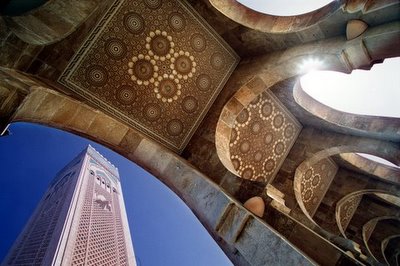 Photo credit: Zany
Photo credit: Zany
The impressive Hassan ll Mosque is the 3rd largest religious monument in the World, with fantastic views over the Atlantic Ocean. This is one of the few mosques that non-Moslems may enter - and it is worth it. One of the great buildings of the world.
Temara: Lies on the coast, some 13Km from Rabat. It is a favourite weekend spot for city dwellers. Temara has a sandy beach, along with many hotels, nightclubs, restaurants, a zoo and other leisure facilities to entertain visitors.
Tangier
Tangier was once a playground for the rich and famous seeking a fashionable café culture as well as a tax haven. When Spain relinquished Tangier back to Morocco in 1960, its duty-free status went with it, along with the fashionable crowd. The decayed grandeur of today still has much to offer and slowly Tangier is regaining its splendor as an attractive tourist destination.
Grand Socco: Socco means Souk in Spanish and it is named so due to its Spanish heritage. A Souk is a market to us and is an interesting place to watch passing Rif people in colourful costumes selling vegetables and fresh mint. It begins at a busting square and the medina is entered from the square, through a large arched entrance.
Kasbah: dates back to the 17th century and it is interesting to wonder through its little alleyways, patios and hidden terraces. The Kasbah Mosque boasts an unusual octagonal minaret.
Sultan’s Gardens, Rue Riad Sultan, just north of the Kasbah Mosque, are a pleasant place to visit and watch the local craftsmen at work while sipping mint tea and enjoying views across the Straits of Gibraltar to Tarifa on the Spanish coast, only 14.5 Km away.
Dar el Makhzen: This is a 17th century palace containing and impressive collection of art from all regions of Morocco.
Forbes Museum: This is located in the Marshan Villa district, about 20 minutes walk from the medina. The museum is the former palace of United States multi-millionaire and media magnate, Malcolm Forbes. The house is open to the public and houses Forbes’ collection of 8,000 miniature soldiers!
Chefchaouen
Chefchaouen was first settled by Spanish Muslim refugees in the middle-ages and has retained its distinctive Spanish character. It is just an hour’s drive from Tangier in the Rif mountains.

The medina is beautiful and bustling with craftsmen working diligently and tradesmen selling the usual fare of carpets, leather goods, pottery and copper utensils. The Great Mosque, in the middle of the medina dates to the 17th century sits on a picturesque square with restaurants and cafes.
Asilah
Located south of Tangier, Asilah is a very poplular seaside resort, famous for its nearby Paradise Beach. Paradise Beach is a short taxi or a fun horse and cart ride from the village and is famous for its enormous expanse of unspoilt white, sandy beach.
Despite growing numbers of visitors, Asilah has retained its relaxing atmosphere. Asilah is known as the Artists’ Village and here you can find many locally painted canvases adorning the souks of its 15th century medina. The town is small enough to explore on foot or by donkey cart and is renowned for its great seafood restaurants.
In Conclusion - whatever you do on your trip make certain you get to meet the Moroccan people. They are warm, hospitable and will make you feel welcome.
